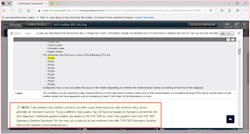This article has been updated from its original 2018 version.
In most cases today’s engine management systems allow for a quick and accurate diagnosis when driveability issues are present. When symptoms exist and there are no codes, it becomes a little more difficult. And when there are no codes and the issue is intermittent, the difficulty factor grows exponentially.
In this Tool Briefing we will discuss a multiple-symptom issue (with no codes), and which tools you can use to determine the cause and correct the issue.
Step 1 – Obtain vehicle specific information
Whenever you are faced with any problem with a vehicle, you need to obtain as much understanding of the issue, and the potential causes, that you can. When dealing with an intermittent problem, acquiring as much specific information as possible will not only allow you to speed the diagnostic process up, but be more accurate in your diagnosis.
One of the best sources of specific vehicle information is the driver of the vehicle. This may not necessarily be the person who brought the vehicle in. It could be a spouse, child, or even a co-worker that you need to speak with, in order to get the details of what the conditions are when the issue occurred/occurs.
Some critical questions that will help to duplicate the issue include:
- What speeds and load are present when it happens?
- Is the engine warmed up or cold?
- How much fuel is in the tank?
- What type of fuel do you use?
- What type of driving when it occurs: highway or stop-and-go?
- Have any repairs or services been performed prior to the symptom?
- Have any repairs been done to try to correct the issue?
These are just a few pieces of information that will allow the technician to duplicate the issue, which is one of the most critical steps to make sure the vehicle is repaired properly. In my opinion, if a technician cannot duplicate the issue, he or she should not repair or replace anything, mainly because they cannot repeat the problem to see whether it is fixed.
A critical part of vehicle specific information includes details such as the VIN, mileage, and if any codes are present. Use your scan tool to check for current (as well as history) codes and monitor status. History codes can be an indicator of issues that the vehicle has but are not present at this moment. This is the very definition of “intermittent”. Monitors that are not complete may indicate that codes have been recently cleared.
In this case, I interviewed the customer and found they had been experiencing an intermittent rough idle, along with an occasional hesitation when accelerating from a stop, mostly after the vehicle was warm. They also stated they took the car to an auto parts store that advertises a “free diagnosis.” The parts store connected their “computer” to the car and told them they needed spark plugs and ignition coils, and maybe fuel injectors. The customer decided they needed a second opinion and brought the car into our shop.
No existing codes were found, but the scan did show that many of the monitors were not complete, indicating the codes had probably been cleared recently. When there are no codes, but there is a misfire that would typically trigger a code, use your vehicle information database to determine what the enabling criteria for setting a code is. In the case of a misfire a P0300 (random or multiple cylinder misfire), or specific cylinder P0301-P0306 should have triggered. We used Mitchell 1 to look up the information for setting a P0300. One of the conditions that is required to set the code is a fuel level over 11 percent. During our initial inspection, we noted that the fuel level was well under a quarter tank on the gauge, which is why there may not be a current code.
We also checked for TSBs and pattern failures. There was a TSB for carbon build-up and the approved cleaning method, and another TSB for the use of “Top Tier” gasoline.
One other item of note on the initial inspection was the dash was indicating an oil change was due, and a scan of the oil life monitor also indicated zero life. The oil level was full and the oil appeared somewhat clean, but there are only 28,000 miles on the vehicle.
At this point we had a few ideas of what was wrong with the vehicle, but we decided another discussion with the customer was in order before proceeding. The answers to additional questions would likely reveal our next steps in order to confirm our thoughts.
Since we noted the fuel level was low, it would be good to know if they usually keep the level low. Consistently driving the vehicle with low fuel levels can contaminate the fuel injectors and pump with sediment.
The customer revealed they do not usually fill the tank because they don’t drive it that much. They also stated they use 87 octane fuel from the least expensive source they can find. It should be noted that GM recommends mid-grade, 89 octane fuel for this vehicle. They also said the oil had not been changed for about a year.
Armed with as much information as we were able to obtain from the customer, an initial scan, TSBs, and additional data from Mitchell 1, we have a strong suspicion the problems this customer is experiencing are due to carbon buildup on the back side of the intake valves.
This is a Gasoline Direct Injection (GDI) engine; these engines have a propensity to build carbon on the valves, especially if the vehicle operates under many of the conditions, we have found on this one. Consistently driving short trips does not allow the engine to reach and sustain a temperature that will boil off moisture in the crankcase. That, combined with extended interval oil changes, will allow oil to accumulate on the back side of the intake valves, eventually turning it into carbon. When carbon builds up, airflow past the valves is disturbed, which may cause either over-or under-fueling of the cylinders, therefore a misfire. Keep in mind this car is eight years old with only 28,000 miles, which calculates to only 3,500 miles per year.
Step 2 – Test the vehicle
Again, it is never a good idea to just jump into repairs without having duplicated the issue, and performing various tests to complete a diagnosis. With no codes to start with, the next step is to drive the vehicle in order to duplicate the issue. After driving the vehicle for around 20 minutes, we were able to experience the issue, and confirm it only misfires, at idle.
A scan of the data stream showed a few interesting items. The bank 2 Oxygen sensor voltage was continually biased higher than bank 1 voltage. The scan tool also provides a PID for long-term fuel trim average, for both banks. As seen in the image, the average for bank 2 is -99, meaning the injectors are being commanded to reduce the amount of fuel being delivered to that bank.
Based on the scan readings, it appears that bank 2 has either an injector leaking fuel into a cylinder, or a carbon build-up is disrupting airflow into the cylinders.
With the tendency of GDI engines to carbon up intake valves, and either disrupt air flow, or cause valves to stick, it is much more likely that a carbon buildup is the issue rather than a faulty injector. Being that the issue is intermittent and seems to be related to warm, not cold temperature, it seems to be a reasonable assumption that it is not a sticking valve. Sticking valves will typically be an issue with a cold engine.
With the low mileage on the vehicle, the apparent poor maintenance, and the conditions the vehicle is operated in, it appears the most likely cause of the misfire is carbon buildup.
In order to help document our diagnosis, we removed the spark plugs to see how much, if any, carbon was on the plugs. We also used a borescope to check for carbon on the piston tops. Checking for carbon on the intake valves would require removing the intake plenum, which the customer did not want to do at this time.
As seen in the image, there was a substantial amount of carbon on the plugs, especially considering the low number of miles on the car. Interestingly, cylinders on bank 1 all showed less carbon than bank 2. This can usually be explained by where PCV or vent hoses are introduced into the intake plenum.
Step 3 – The repair
Fuel injection flushes that are added into the fuel will not work to remove carbon from the valves, although it can help with cleaning the piston tops and in some cases, the injectors. Using a chemical flush that is introduced into the intake manifold will typically work on engines that have relatively low mileage like this one. We connected our injection cleaning machine to the engine and flushed the system. Our system uses a three-part chemical: one that is a solvent that loosens carbon, another to wash the carbon out, and another that adds a cleaner to the fuel.
Step 4 – Confirm the repair
Since this was an intermittent issue we wanted to make sure the vehicle was completely repaired. We have scan readings that showed an issue, carbon on the spark plugs, and a drive test where we experienced the problem. After cleaning the system, we drove the vehicle under the same conditions we experienced the misfire, and we did not feel a miss. We removed the plugs after we drove the car and they showed less carbon than they did previously. The image from the borescope also showed less carbon on the piston tops. Current scan tool readings also showed oxygen sensor and fuel trim readings in the normal range. Don’t forget if you are going to monitor PIDs like fuel trims after a repair, if the codes were cleared, your road test will need to include the proper drive cycle conditions to complete the monitor for that system, which in this case included adding fuel to the vehicle.
Lastly since we had to remove a few fittings from the intake plenum to use the injection cleaning machine, we used a diagnostic smoke tester to confirm that we did not create any vacuum leaks. This test only takes a few moments, but can save an incredible amount of time to assure a repair has been done properly.
To sum it up, this diagnosis and repair was relatively straightforward, and it would have been very easy to just go straight to performing an injection cleaning service. It would have cured the customer’s issue. The problem with jumping to a repair, rather than performing a complete diagnosis, is that your assumptions could be wrong and you do not fix the vehicle. Performing a complete diagnosis with supporting documentation before and after the repair allows you to share your findings with the customer and be sure the repair is complete.
Tools used:
- Vehicle Repair Information
- Scan Tool
- Borescope
- Fuel Injection/Induction Cleaner
- Diagnostic Smoke Tester
About the Author

Barry Hoyland
Barry Hoyland has been in the independent aftermarket for more than 45 years as a technician, technician instructor, shop owner, and shop management consultant. He owned and operated a successful Southern California automotive repair center that offers complete auto care and specialized in emission and diagnostic services for over 28 years. Hoyland also owned a company that modified vehicles to perform as emergency response units and mobile command centers, incorporating high-end electronic components into today’s vehicles. Hoyland has experience with all size and types of vehicles including traditional gas, hybrid electric, alternative fuel, and heavy duty diesel trucks.
Hoyland has provided consulting services for many automotive shops, fleets, and government agencies in order to improve their operational efficiencies.
In addition, he has worked with many NHRA drag racing teams as a crew chief on supercharged alcohol and nitro-methane fueled cars and currently serves as a crew chief on a Top Alcohol Funny Car, a Nostalgia Funny Car, and a Nostalgia Alcohol Dragster
Hoyland holds certifications in ASE: A1, A6, A8, and L1, MACS 609, maintains a California Advanced Emission license, and a CDL with endorsements for double and triple trailers, tankers, and HazMat.
When he is not helping to run a shop in the Pacific Northwest, Hoyland travels across the U.S. as an instructor of technical and shop management courses, many of which he has developed.





